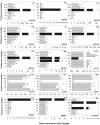Transcriptomic profiling during the post-harvest of heat-treated Dixiland Prunus persica fruits: common and distinct response to heat and cold
- PMID: 23236430
- PMCID: PMC3516522
- DOI: 10.1371/journal.pone.0051052
Transcriptomic profiling during the post-harvest of heat-treated Dixiland Prunus persica fruits: common and distinct response to heat and cold
Abstract
Cold storage is extensively used to slow the rapid deterioration of peach (Prunus persica L. Batsch) fruit after harvest. However, peach fruit subjected to long periods of cold storage develop chilling injury (CI) symptoms. Post-harvest heat treatment (HT) of peach fruit prior to cold storage is effective in reducing some CI symptoms, maintaining fruit quality, preventing softening and controlling post-harvest diseases. To identify the molecular changes induced by HT, which may be associated to CI protection, the differential transcriptome of peach fruit subjected to HT was characterized by the differential display technique. A total of 127 differentially expressed unigenes (DEUs), with a presence-absence pattern, were identified comparing peach fruit ripening at 20°C with those exposed to a 39°C-HT for 3 days. The 127 DEUs were divided into four expression profile clusters, among which the heat-induced (47%) and heat-repressed (36%) groups resulted the most represented, including genes with unknown function, or involved in protein modification, transcription or RNA metabolism. Considering the CI-protection induced by HT, 23-heat-responsive genes were selected and analyzed during and after short-term cold storage of peach fruit. More than 90% of the genes selected resulted modified by cold, from which nearly 60% followed the same and nearly 40% opposite response to heat and cold. Moreover, by using available Arabidopsis microarray data, it was found that nearly 70% of the peach-heat responsive genes also respond to cold in Arabidopsis, either following the same trend or showing an opposite response. Overall, the high number of common responsive genes to heat and cold identified in the present work indicates that HT of peach fruit after harvest induces a cold response involving complex cellular processes; identifying genes that are involved in the better preparation of peach fruit for cold-storage and unraveling the basis for the CI protection induced by HT.
Conflict of interest statement
Figures






Similar articles
-
Heat treatment of peach fruit: modifications in the extracellular compartment and identification of novel extracellular proteins.Plant Physiol Biochem. 2012 Nov;60:35-45. doi: 10.1016/j.plaphy.2012.07.021. Epub 2012 Aug 3. Plant Physiol Biochem. 2012. PMID: 22902552
-
Comparative EST transcript profiling of peach fruits under different post-harvest conditions reveals candidate genes associated with peach fruit quality.BMC Genomics. 2009 Sep 10;10:423. doi: 10.1186/1471-2164-10-423. BMC Genomics. 2009. PMID: 19744325 Free PMC article.
-
Biochemical and proteomic analysis of 'Dixiland' peach fruit (Prunus persica) upon heat treatment.J Exp Bot. 2009;60(15):4315-33. doi: 10.1093/jxb/erp267. Epub 2009 Sep 4. J Exp Bot. 2009. PMID: 19734260
-
Deciphering the metabolic pathways influencing heat and cold responses during post-harvest physiology of peach fruit.Plant Cell Environ. 2014 Mar;37(3):601-16. doi: 10.1111/pce.12181. Epub 2013 Sep 8. Plant Cell Environ. 2014. PMID: 23937123
-
Fundamental aspects of postharvest heat treatments.Hortic Res. 2014 Jun 25;1:14030. doi: 10.1038/hortres.2014.30. eCollection 2014. Hortic Res. 2014. PMID: 26504541 Free PMC article. Review.
Cited by
-
Generation of fruit postharvest gene datasets and a novel motif analysis tool for functional studies: uncovering links between peach fruit heat treatment and cold storage responses.Planta. 2020 Jan 16;251(2):53. doi: 10.1007/s00425-020-03340-2. Planta. 2020. PMID: 31950388
-
De-novo assembly of mango fruit peel transcriptome reveals mechanisms of mango response to hot water treatment.BMC Genomics. 2014 Nov 5;15(1):957. doi: 10.1186/1471-2164-15-957. BMC Genomics. 2014. PMID: 25373421 Free PMC article.
-
Omics studies of citrus, grape and rosaceae fruit trees.Breed Sci. 2016 Jan;66(1):122-38. doi: 10.1270/jsbbs.66.122. Epub 2016 Jan 1. Breed Sci. 2016. PMID: 27069397 Free PMC article. Review.
-
Fruit Decay to Diseases: Can Induced Resistance and Priming Help?Plants (Basel). 2018 Sep 21;7(4):77. doi: 10.3390/plants7040077. Plants (Basel). 2018. PMID: 30248893 Free PMC article. Review.
-
Integrated analysis of transcriptomics and metabolomics of peach under cold stress.Front Plant Sci. 2023 Mar 27;14:1153902. doi: 10.3389/fpls.2023.1153902. eCollection 2023. Front Plant Sci. 2023. PMID: 37051086 Free PMC article.
References
-
- Lurie S, Crisosto CH (2005) Chilling injury in peach and nectarine. Postharvest Biol Technol 37: 195–208.
-
- Ogundiwin EA, Martí C, Forment J, Pons C, Granell A, et al. (2008) Development of ChillPeach genomic tools and identification of cold-responsive genes in peach fruit. Plant Mol Biol 68: 379–397. - PubMed
-
- Falara V, Manganaris GA, Ziliotto F, Manganaris A, Bonghi C, et al. (2011) A ß- D -xylosidase and a PR-4B precursor identified as genes accounting for differences in peach cold storage tolerance. Funct Integr Genomics 11: 357–368. - PubMed
Publication types
MeSH terms
LinkOut - more resources
Full Text Sources

